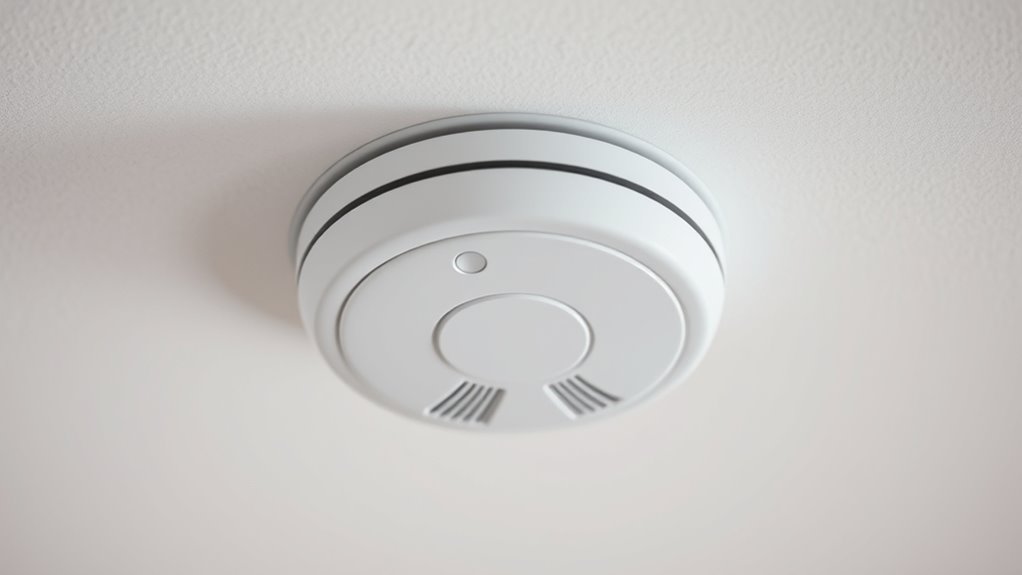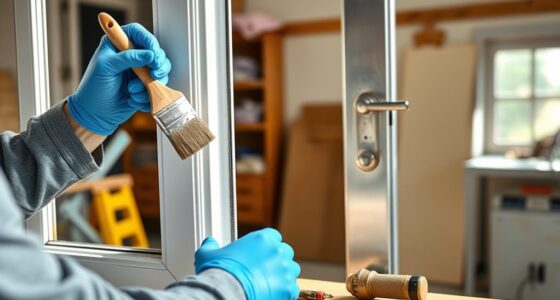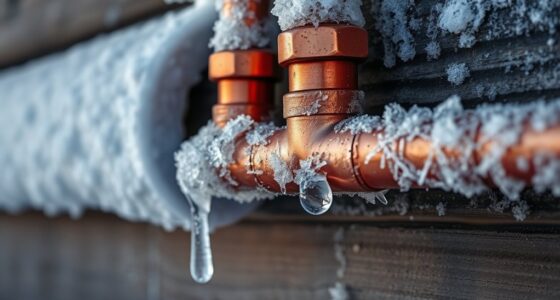To keep your smoke and CO alarms working properly, test them once a month by pressing and holding the test button until they sound. Make sure they activate fully and check for any dust or debris obstructing sensors. Replace batteries annually or when you hear warning chirps. Hardwired units should be inspected for power. Regular testing and maintenance make sure they’re ready when needed, so stay tuned for detailed steps to protect your home effectively.
Key Takeaways
- Test smoke and CO alarms monthly by pressing and holding the test button until they sound.
- Follow manufacturer instructions for specific testing procedures for each alarm type.
- Check for obstructions like dust or cobwebs, and clean alarms regularly to ensure sensor accuracy.
- Replace batteries annually or when low-battery chirps occur; inspect hardwired units for proper power connection.
- After maintenance or battery replacement, perform a full test to confirm alarms are fully operational.

Smoke and carbon monoxide alarms are essential safety devices that can save lives by alerting you to potential dangers early. Regularly testing these alarms isn’t just a good idea—it’s a vital part of maintaining a safe home environment. When you test your alarms, you ensure they’ll perform correctly in an emergency, giving you peace of mind and a better chance of reacting swiftly if danger strikes.
Start by understanding how often you should test your alarms. The general rule is once a month, but it’s also wise to check the manufacturer’s instructions for specific recommendations. Setting a recurring reminder on your phone or calendar can help you stay consistent. Testing isn’t just about pressing a button; it’s about verifying that the alarm is fully functional and ready to alert you at any moment.
Test your alarms monthly and follow manufacturer guidelines for optimal safety.
To test your smoke alarm, press and hold the test button until you hear the loud alarm sound. If it doesn’t sound, it’s a sign that the device may need new batteries or replacement. Remember, some alarms have a different testing method, so consult the user manual if you’re unsure. For carbon monoxide alarms, the testing process is similar; press the test button and listen for the alarm. If it doesn’t activate or sounds weak, replace the batteries or the entire unit if necessary. It’s vital to use the proper testing method to confirm your alarms will function correctly when it counts.
While testing, take the opportunity to inspect the alarm’s physical condition. Check for dust, dirt, or cobwebs that could interfere with its sensors. Gently vacuum around the alarm to remove debris, and wipe it with a damp cloth if needed. Ensure the alarms are mounted securely on the ceiling or wall and that the vents are clear. Proper placement and regular cleaning improve the device’s sensitivity and reliability. Additionally, understanding the contrast ratio of your alarms and their sensors can help you better interpret their performance and reliability over time.
Don’t forget to replace batteries annually or whenever they’re weak, even if the alarm hasn’t chirped. Some alarms have a low-battery warning chirp, indicating it’s time for fresh batteries. If your alarm is hardwired, test the power connection and replace or repair any faulty wiring. After replacing batteries or servicing the device, always run a test again to confirm everything works correctly.
Frequently Asked Questions
How Often Should I Replace Smoke and CO Alarm Batteries?
You should replace your smoke and CO alarm batteries at least once a year to guarantee they work properly. If your alarms use 9-volt batteries, change them when you set your clocks for daylight saving time, or if the alarm chirps indicating low battery. Regular testing and replacing batteries promptly keep your alarms functioning correctly, providing essential early warnings in case of fire or carbon monoxide leaks.
Are There Different Testing Procedures for Smart Alarms?
Yes, smart alarms have unique testing procedures that are more advanced than traditional models. You’ll want to open the app, press the test button, and sometimes even walk through specific steps to guarantee all features work perfectly. These alarms use Wi-Fi, Bluetooth, or smart home integrations, so regular button presses aren’t enough. Follow the manufacturer’s instructions carefully to keep your smart alarm functioning flawlessly and ensure your home’s safety is never compromised.
What Signs Indicate a Smoke or CO Alarm Is Malfunctioning?
If your smoke or CO alarm beeps unexpectedly, malfunctions are likely. Also, if it fails to sound during a test or when you press the test button, it’s a sign it’s not functioning properly. You might notice dead or missing batteries, dust buildup, or corrosion around the sensors. If the alarm appears damaged or outdated, it’s time to replace it. Regular checks help guarantee your safety devices operate when needed.
Can Pets Trigger False Alarms During Testing?
Pets can indeed trigger false alarms during testing because their fur, dander, or even movement can set off sensitive smoke and CO detectors. You might notice your alarm sounding unexpectedly when your pet jumps or moves around near the device. To prevent this, make certain pets are away during testing, and consider installing pet-friendly alarms or protective covers designed to minimize false triggers caused by pet activity.
How Do I Know if My Alarm’s Sensor Is Still Effective?
You can check if your alarm’s sensor is still effective by performing regular tests using the test button, which mimics smoke or CO presence. If the alarm sounds loudly, it’s working properly. If it doesn’t respond or the sound is weak, replace the batteries or the entire unit. Also, keep an eye on the alarm’s indicator lights, and replace the device every 7-10 years to guarantee ongoing reliability.
Conclusion
Remember, your smoke and CO alarms are like silent guardians watching over you in the shadows. Regular testing is their way of flexing their muscles, proving they’re ready to protect when it counts. Don’t wait for a warning cry—be proactive and keep their vigilance sharp. Think of it as giving your safety net a quick check-up; because when disaster strikes, you want these alarms to be as dependable as your own heartbeat.









